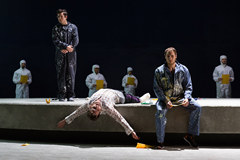| Opera Reviews | 25 April 2024 |
Doctor Atomic has a more powerful explosionby Steve Cohen |
|
Adams: Doctor Atomic |
|
|
In truth, almost all of them were thrilled that they’d be bringing an early end to World War II. The anxiety that some of them felt was a fear that the bomb would be a dud, causing all of their work to be considered a failure. This fact was confirmed when I spoke with almost all the surviving scientists at Los Alamos in 1992 on the occasion of the 50th anniversary of the start of the project. A reversal of opinion did occur after the end of the war, and Oppenheimer voiced regrets. When Hiroshima was destroyed, however, Oppenheimer led a celebration and clasped his hands above his head as if he were a boxer who’d just won a championship fight. Maybe those men should have foreseen the ethical problems sooner, but it’s false to pretend that they had severe doubts before the test explosion. A new production of the opera this month by the Curtis Institute of Music in Philadelphia is more effective than all that I’ve seen before, due to the unusual direction by R. B. Schlather. While earlier productions tried to simulate the laboratory and the testing site in New Mexico, this production did not. It used a bare graphite-grey stage with no scenery or props. And while earlier productions cast singers who resembled the historic figures, this went diametrically opposite. Schlather chose the stocky baritone Jonathan McCullough to portray the famously skinny Oppenheimer, and he picked the blonde-haired Siena Licht Miller to play Kitty whose hair is specifically referred to in the libretto as dark. The Met’s production had the singers hold signs with photographs of each of the real scientists; this production does not. It treats its characters as apocryphal figures. And because the opera no longer is being presented as a factual documentary, I was able to set aside my earlier objections. Now the opera no longer is literal, but is fanciful and atmospheric. This makes the long, meandering poetry seem appropriate. Adams’s music — throbbing, clashing, inspiring — makes those long stretches interesting. Oppenheimer called the test site Trinity, based on Donne’s sonnet “Batter my heart, three-person’d God.” Its words are used in a great dramatic aria that closes the first act. McCullough sang it passionately, accompanied by pounding rhythmic chords from the orchestra. This production encouraged audience members to let their imaginations soar, and allow Adams’s brooding, relentless music to make greater effect than previously. As McCullough sang he lept upward as if grasping for an understanding of the universe. At other times he twisted and tumbled, physically demonstrating how he’s overwhelmed by conflicted emotions. Baritone Tyler Zimmerman as Edward Teller displayed nervous tics and maniacal giggles when singing about the huge power of the weapon, thus giving him a resemblance to Mefistofeles. (Teller later invented the hydrogen bomb which was many times more powerful than the weapons used in 1945.) Schlather has the physicists wear hazmat suits and masks while Oppenheimer wore a bright orange jump suit, conveying the idea of grave danger and of Oppenheimer’s eccentric personality. Another innovation was presenting Kitty Oppenheimer as a sexual temptress. When she pressed her body against Robert’s, he pushed her away, which indicated that he had greater passion for the work of producing the bomb. The 32 members of the chorus moved choreographically in consonance with the music, instead of trying to imitate occupational comings and goings. All of this caused us to succumb to our feelings rather than think about plot. We were seeing mythology, comparable to Wagner’s Ring of the Nibelungen. The Curtis orchestra, led by Timothy Myers, played Adams’s score magnificently. Additional powerful singing came from Vartan Gabrielian as General Groves, Evan LeRoy Johnson as Robert Wilson, and Sophia Fiuza Hunt as Pasqualita, a Native American mother.
|
|
| Text ©
Steve Cohen Photo © Karli Cadell |

 The music by John Adams for Doctor Atomic is the greatest achievement of his career. The libretto, however, presents the problem that Peter Sellars slanted it to imply that most of the scientists who developed the atomic bomb suffered angst that they were committing a moral crime.
The music by John Adams for Doctor Atomic is the greatest achievement of his career. The libretto, however, presents the problem that Peter Sellars slanted it to imply that most of the scientists who developed the atomic bomb suffered angst that they were committing a moral crime.





